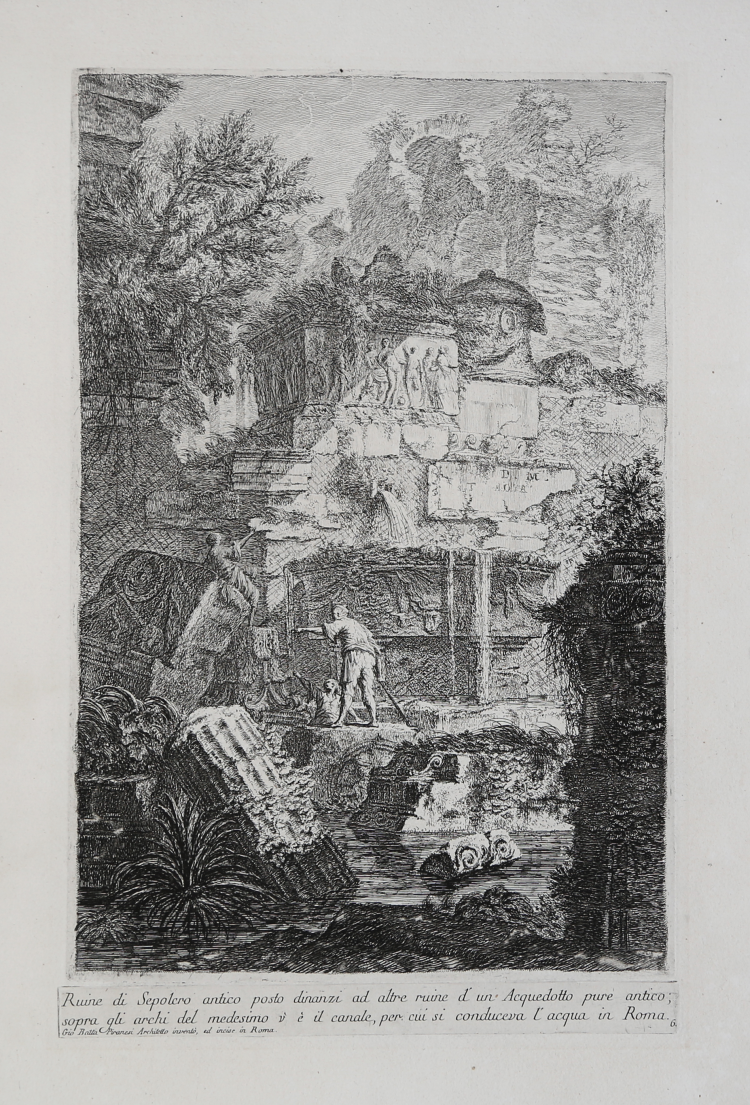



| Reference: | S7581 |
| Author | Giovan Battista PIRANESI |
| Year: | 1750 |
| Measures: | 374 x 249 mm |


| Reference: | S7581 |
| Author | Giovan Battista PIRANESI |
| Year: | 1750 |
| Measures: | 374 x 249 mm |
Etching with engraving and drypoint, signed on plate at lower left.
Example in the second state of five. This work is part of the project, begun in 1743, called Prima parte di Architetture e Prospettive.
Prima parte di Architetture e Prospettive is a publication by the young Piranesi, who had just settled in Rome. The result is a work that is not entirely unified, characterized by the notable stylistic difference between the plates, but of great charm and that lets you guess and predict future artistic developments. The work continues a tradition of a well-established model, which included the whim and the view, the scenography and the treatise on architecture, but later, analyzing the artist's biography, it will be understood to be above all the outburst of a crisis as an architect and of an inner journey lived with intensity. In short, the result of the clash between a mind tied to Venetian culture, heir to the poetry of ruins evoked by Marco Ricci and taken up by Bellotto and Canaletto, and the new architectural culture that was forming in the young Piranesi. Prima parte di Architetture e Prospettive and the subsequent architectural fantasies that continue it constitute a decisive step towards the goal he set himself in the preface to the work: to ensure that architectural caprice would lead to free architecture from the chains of the material and social world, to make it a truly liberal art. The work was an immediate success with the public.
As mentioned, the first edition of the work dates back to 1743, and was dedicated to Nicola Giobbe, a great impresario at the service of the Camera Apostolica and protector of the young Venetian architect. Later it was included in a wider discourse that included the four Capricci and published in the Opere Varie di Architettura Prospettive Grotteschi Antichità Inventate ed incise da Giambattista Piranesi Architetto Veneziano printed by Giovanni Bouchard in 1750.
|
Robison 17 II/V, Wilton Ely 6, Focillon 6
|
Giovan Battista PIRANESI (Mogliano Veneto 1720 - Roma 1778)
|
Italian etcher, engraver, designer, architect, archaeologist and theorist. He is considered one of the supreme exponents of topographical engraving, but his lifelong preoccupation with architecture was fundamental to his art. Although few of his architectural designs were executed, he had a seminal influence on European Neo-classicism through personal contacts with architects, patrons and visiting artists in Rome over the course of nearly four decades. His prolific output of etched plates, which combined remarkable flights of imagination with a strongly practical understanding of ancient Roman technology, fostered a new and lasting perception of antiquity. He was also a designer of festival structures and stage sets, interior decoration and furniture, as well as a restorer of antiquities. The interaction of this rare combination of activities led him to highly original concepts of design, which were advocated in a body of influential theoretical writings. The ultimate legacy of his unique vision of Roman civilization was an imaginative interpretation and re-creation of the past, which inspired writers and poets as much as artists and designers.
|
|
Robison 17 II/V, Wilton Ely 6, Focillon 6
|
Giovan Battista PIRANESI (Mogliano Veneto 1720 - Roma 1778)
|
Italian etcher, engraver, designer, architect, archaeologist and theorist. He is considered one of the supreme exponents of topographical engraving, but his lifelong preoccupation with architecture was fundamental to his art. Although few of his architectural designs were executed, he had a seminal influence on European Neo-classicism through personal contacts with architects, patrons and visiting artists in Rome over the course of nearly four decades. His prolific output of etched plates, which combined remarkable flights of imagination with a strongly practical understanding of ancient Roman technology, fostered a new and lasting perception of antiquity. He was also a designer of festival structures and stage sets, interior decoration and furniture, as well as a restorer of antiquities. The interaction of this rare combination of activities led him to highly original concepts of design, which were advocated in a body of influential theoretical writings. The ultimate legacy of his unique vision of Roman civilization was an imaginative interpretation and re-creation of the past, which inspired writers and poets as much as artists and designers.
|